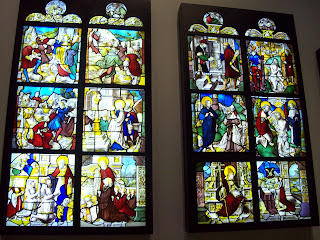Location: Victoria & Albert Museum, London
The V&A, as it is better known as, lies almost adjacent to the Natural History Museum and the Science Museum. Following the same style of building as the surrounding area, but taken to a grand level, this impressive place offers nothing of what is inside.
The museum was founded in 1852, it houses one of the largest collections of art in every single medium, from all corners of the world, and from all of human history. Named after Queen Victoria and Prince Albert, the museum has 143 galleries, and it is one or two of these that is the focus of this post.
The museum houses artifacts collected or donated from around the world, and are organised by region and era that they came from. So this visit introduces an interesting room in the museum, the Rennaissance Europe, from 1400 to 1600. While not covering the entire collection, this review takes a sample of one of the many rooms on offer, in a long hall with a high arched glass roof. The room is a tasteful cream colour, with dark marble columns at each end.
Starting at one end of the room, the most immediate artifact is a large stone well head decorated with the arms of the Concoreggio family, dating to 1450. Nearby lie the stemma and roundels of various family arms, such as Réne of Anjou; the roundels are of classical heads, intricately made of ceramic.
There are some statues on the other side of the room, depicting characters from classical Greek, Roman mythology, and biblical heroes. Some notable examples woulb be Jason with the Golden Fleece, Samson slaying a Philistine, and the Rape of Proserpina. The statues show the Rennaissance tendency to the dramatic in depicting classical and biblical scenes, but the Jason statue shows a more calm, satisfied scene of Jason with his Golden Fleece.
Moving past these to the wall, there are a number of interesting architectural and decorative pieces. Some of these would be a doorway, though little other information was given, top of a Dormer window, balcony panels from the Palazzo Pola, and a Dormer window from Montal, all dating from 1490 to 1557. These were attractive pieces that intrigued the author's attention in depicting how the streets of those times would have looked, with that distinctive architecture.
 |  |
More statues are found around this point, amongst a plethora of capitals (column heads) and well heads, in the style of the Rennaissance families of Italy. Of these, there is the highly intricate and delicate looking fountain surmounted by a small statuette of David, matching and adjacent statues of Apollo and Zephyr, and one of Saint George and the Dragon.
 |  |
The last few exhibits in this sections are of a morbid nature, starting with the oddly-shaped tombstone of Antonio and Caterina Maggi de Bassano from 1520, the grand Monument of the Marchese Spineta Malaspina, funerary chapel doorways, and a selection of richly carved effigies such as Don García de Osorio and Doña María de Perea. Finally, worth looking at is the tomb for a member of the Moro family.
The next half of this unfolded in a distinctly christian theme, with the room filled with exhibits from a number of churches, monasteries, and abbeys. For example, as labeled, some very good altarpieces to view include the 'Life of the Virgin', the 'Virgin, Child and God', with the 'Adoration of the Shepherds', the distinctly vandalised Sutton Valence altarpiece, and lastly the Troyes altarpiece.
 |  |
Stained glass windows are dotted around and illuminated, such as the Mariawald windows, windows showing St. Peter and St. Paul, and many others around the edges of the hall. Statuettes are also a prominent feature of churches, and in line with this is a collection of many such statuettes of figureheads. One set of statuettes all feature St. Catharine of Alexandria, St. Peter, St. Paul, and St. Ursula. There was a semi-decayed wooden statuette of the Angel Gabriel, then there was St. Margaret and the Dragon, and finally St. Peter again. While not exhaustive at all, these are some particular examples that should be regarded on any visit.
 |  |
There was a large altar frame around a painting of the Virgin of Soreto with St. Jerome. The end of the room contains an altarpiece and tabernacle from the Santa Chiara Chapel which dates back to 1400. Behind this, there is a selection of other church artifacts of an even richer nature, such as the expensive metal pieces, incense holders, chalices, candlesticks, and metal altar crucifixes. On the other side is a selection of the fine cloth and robes worn by members of the church, including a selection of various mitres.
This concludes this particular section of the V&A museum, and there will be many more visits to come, especially in this area which offers so much for the visitor to see. Photographs are courtesy of the author himself, once he finally worked out how to download them to his computer!







No comments:
Post a Comment